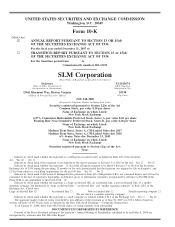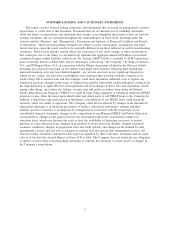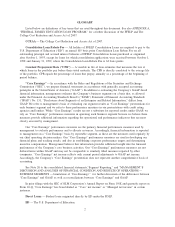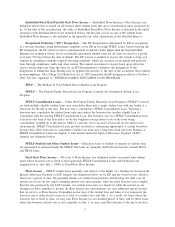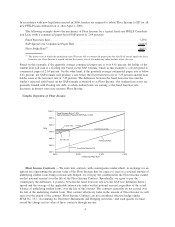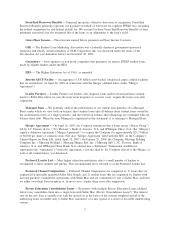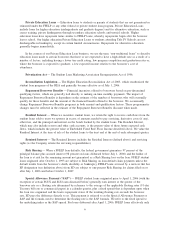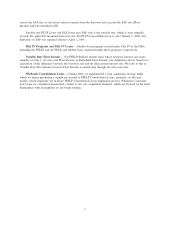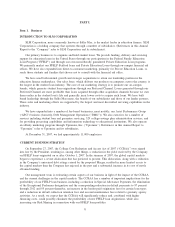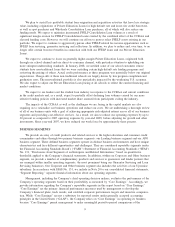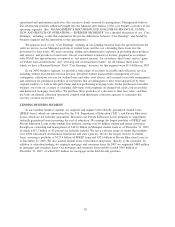Sallie Mae 2007 Annual Report Download - page 3
Download and view the complete annual report
Please find page 3 of the 2007 Sallie Mae annual report below. You can navigate through the pages in the report by either clicking on the pages listed below, or by using the keyword search tool below to find specific information within the annual report.GLOSSARY
Listed below are definitions of key terms that are used throughout this document. See also APPENDIX A,
“FEDERAL FAMILY EDUCATION LOAN PROGRAM,” for a further discussion of the FFELP and The
College Cost Reduction and Access Act of 2007.
CCRAA — The College Cost Reduction and Access Act of 2007.
Consolidation Loan Rebate Fee — All holders of FFELP Consolidation Loans are required to pay to the
U.S. Department of Education (“ED”) an annual 105 basis point Consolidation Loan Rebate Fee on all
outstanding principal and accrued interest balances of FFELP Consolidation Loans purchased or originated
after October 1, 1993, except for loans for which consolidation applications were received between October 1,
1998 and January 31, 1999, where the Consolidation Loan Rebate Fee is 62 basis points.
Constant Prepayment Rate (“CPR”) — A variable in life of loan estimates that measures the rate at
which loans in the portfolio pay before their stated maturity. The CPR is directly correlated to the average life
of the portfolio. CPR equals the percentage of loans that prepay annually as a percentage of the beginning of
period balance.
“Core Earnings” — In accordance with the Rules and Regulations of the Securities and Exchange
Commission (“SEC”), we prepare financial statements in accordance with generally accepted accounting
principles in the United States of America (“GAAP”). In addition to evaluating the Company’s GAAP-based
financial information, management evaluates the Company’s business segments on a basis that, as allowed
under the Financial Accounting Standards Board’s (“FASB”) Statement of Financial Accounting Standards
(“SFAS”) No. 131, “Disclosures about Segments of an Enterprise and Related Information,” differs from
GAAP. We refer to management’s basis of evaluating our segment results as “Core Earnings” presentations for
each business segment and we refer to these performance measures in our presentations with credit rating
agencies and lenders. While “Core Earnings” results are not a substitute for reported results under GAAP, we
rely on “Core Earnings” performance measures in operating each business segment because we believe these
measures provide additional information regarding the operational and performance indicators that are most
closely assessed by management.
Our “Core Earnings” performance measures are the primary financial performance measures used by
management to evaluate performance and to allocate resources. Accordingly, financial information is reported
to management on a “Core Earnings” basis by reportable segment, as these are the measures used regularly by
our chief operating decision makers. Our “Core Earnings” performance measures are used in developing our
financial plans and tracking results, and also in establishing corporate performance targets and determining
incentive compensation. Management believes this information provides additional insight into the financial
performance of the Company’s core business activities. Our “Core Earnings” performance measures are not
defined terms within GAAP and may not be comparable to similarly titled measures reported by other
companies. “Core Earnings” net income reflects only current period adjustments to GAAP net income.
Accordingly, the Company’s “Core Earnings” presentation does not represent another comprehensive basis of
accounting.
See Note 20 to the consolidated financial statements,“Segment Reporting,” and “MANAGEMENT’S
DISCUSSION AND ANALYSIS OF FINANCIAL CONDITION AND RESULTS OF OPERATIONS —
BUSINESS SEGMENTS — Limitations of ‘Core Earnings’” for further discussion of the differences between
“Core Earnings” and GAAP, as well as reconciliations between “Core Earnings” and GAAP.
In prior filings with the SEC of SLM Corporation’s Annual Report on Form 10-K and quarterly report on
Form 10-Q, “Core Earnings” has been labeled as “‘Core’ net income” or “Managed net income” in certain
instances.
Direct Loans — Student loans originated directly by ED under the FDLP.
ED — The U.S. Department of Education.
2

